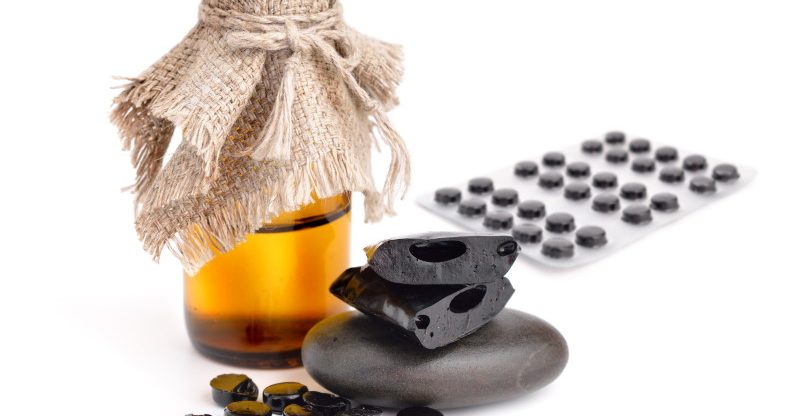11 Evidence-Based Benefits of Shilajit
Most people have never even heard of Shilajit, but this herbomineral is quickly gaining traction in the natural medicine community for its healing properties.
It has been used by practitioners of Ayurveda to rejuvenate and heal the body, and once you hear of all the ways that this biomass can improve your health, you will be wondering why you have not tried it sooner.
Understanding Shilajit
In the Himalayan mountains, Shilajit can be found coming through the layers of rock that form this alpine region.
It oozes out from between crevices, and it contains a rich, dark concentration of minerals, nutrients, and compounds that have healing properties.
Shilajit is gummy-like in texture, and the people who are native to this region have used it for centuries for its ability to heal.
The word Shilajit comes from Sanskrit and translates to “Conqueror of mountains and destroyer of weakness.”
Those who named this substance believed whole-heartedly in its power to treat nearly all diseases.
It goes by other names, as well, including mineral pitch, mineral wax, Asphaltum punjabianum, and black asphaltum as well as unique names among the villages and towns that speckle the sides of the Himalayan Mountains and Tibetan mountains.
While its name is noble and mighty, the substance itself may seem less so in its taste and appearance.
When it comes directly from the earth, Shilajit is gooey and dark, tastes very bitter, and smells strongly like urine.
Today, however, it is available in a processed and purified form in capsule or powder form, which makes it easier to consume.
Nutritional and Chemical Makeup of Shilajit
Because it is created deep within the earth, it is categorized as an herbomineral, as it contains both biological and geological compounds.
Shilajit contains a varied and complex mixture of active compounds and nutrients.
Shilajit is mostly comprised of humus and other organic plant materials that become liquified when they have been compressed by pressure over time.
Under this intense pressure and heat, the compounds change and become beneficial to our bodies.
When the outside temperatures rise and heat up the rocks in the summer, this material begins to squeeze out from cracks in the mountains.
The most abundant minerals and compounds found in Shilajit include (1):
- Fulvic acid
- Humic acid and other uronic acids
- Lipids
- Phenolic glycosides
- Amino Acids
- Small peptides
- Metabolites
- Iron
- Calcium
Your body needs fulvic acid to transport various nutrients into cells while also removing toxins.
The compounds in this herbomineral also improve the efficacy and bioavailability of other supplements and herbal treatments.
Shilajit’s chemical and botanical makeup varies for many reasons.
Factors that influence this include the plant varieties in the region where it was harvested, the soil quality, the geology of the area, climate in the area, and the altitude.
To illustrate this, we can look at Shilajit samples taken from various regions and see that those from northern India contains more fulvic acid than those from Russia, Pakistan, or Nepal.
Each area has its own, unique Shilajit whose composition reflects the local geology, biology, and climate (2).
There are four distinct varieties of Shilajit. Iron-containing Shilajit is the most common and is black or brown in color.
Silver Shilajit is white.
Both copper and gold Shilajit, which are blue and red in color, respectively, are the rarest of this material.
Scientists are still unable to confirm precisely how this substance is formed, and their theories as to its origin are still tentative.
While there has been some research on the use of this substance to improve health, most of what is known at this time still relies heavily on the traditional and folk knowledge of the people of this region.
A Brief History of Shilajit
Documented use and discovery of Shilajit goes back over 3,000 years.
In ancient Sanskrit texts, there is mention of this powerful substance, which then quickly became a staple used in traditional medicine across Asia.
In addition to being used to cure diseases and improve energy levels, Shilajit was also used as an aphrodisiac.
In modern times, Shilajit has regained popularity and use when villagers in the Himalayas noticed that monkeys were eating this gooey substance from between rock layers when they migrate up into the mountains during the summer.
Because this animal was revered for its strength and longevity, the indigenous people attributed these to the Shilajit.
When these same villagers started to consume the tar-like substance as well, they noticed improvements in their health.
They had more energy, enjoyed fewer digestive issues, and saw improvements in their libido, memory, allergies, and overall quality of life.
These changes all seemed to rely on the consumption of this oozing substance found in the rocks near their village, and word has quickly spread.
As more herbal and natural healers became aware of Shilajit’s benefits, it has since been included in a modern supplement, and soon Shilajit was available from many sources to the public around the world.
Using Shilajit
Unlike other supplements and herbal remedies, Shilajit is not as readily available yet.
You cannot just go into a health food store or natural grocer to purchase it, but that day may be coming soon.
You can, however, find online retailers who sell this supplement in one of three common form- powder, resin, or supplements in the form of capsules or tablets.
While each option may have different benefits, most people agree that, because it is the least processed, the resin has more of the pure compounds that are found when Shilajit comes right out of the earth.
If you use resin, mixing just a tiny amount (the size of a pea or smaller) into a glass of water is effective.
Because of the strong tastes of Shilajit, you will want to drink that water quickly or add additional ingredients to it to create a smoothie that will mask the bitter taste.
Supplements can be taken just as you would any other pill, and powders can be mixed into smoothies or tea for consumption.
When buying Shilajit, you want to ensure you are getting yours from a reputable supplier.
Shilajit in its purer form, straight out of the rocks, can also contain heavy metals, mycotoxins, and other harmful substances, which is why we should consume this product only after it is slightly processed to remove these toxins.
In some cases, distributors are selling what they claim is Shilajit, but which contains only trace amounts or no Shilajit at all.
In others, they are adding additives and compounds that make the supplements dangerous to consume.
To protect yourself, you want to purchase your Shilajit from a trusted supplier who will supply a certificate of analysis upon request.
Because the concentration of Shilajit and its numerous compounds can vary between products, it is challenging to know the exact dosage for your needs.
Clinical trials using Shilajit are also few, which makes understanding dosage more difficult.
According to most reviews of Ayurvedic practices and applications, taking between 300 and 500 milligrams per day is safe.
Shilajit’s Health Benefits
From traditional medicine practitioners and medical research, we now know that Shilajit can improve your health in many ways.
It is rich in active compounds and minerals, giving it the power to rejuvenate your cells, give your tissues a boost of energy, and restore healthy levels of nutrients to all your tissues.
Shilajit can enhance hormone levels, especially in men, and by lowering inflammation and providing antioxidant, it is also helpful for our brain, heart, and other organs.
At this time, most of what we know about Shilajit comes from cell studies or animal trials, but a few clinical trials have been performed, and there are surely more to come soon.
Keep reading to learn more about this amazing herbomineral and how it can help your health and improve your wellness.
Improve Male Fertility and Testosterone Levels
In Ayurveda, Shilajit was used to increase libido, but we now know, because of clinical trials, that this substance can indeed boost testosterone and enhance male fertility.
One study involving 98 healthy men showed that taking 250 milligrams of Shilajit twice per day for three months can increase levels of both free and total testosterone.
It also enhanced levels of DHEAS or dehydroepiandrosterone (3).
Because this herbomineral absorbs into all cells, including the testes, it can lower oxidative stress and increase the production of sperm, thus enhancing fertility (4).
Relieves Chronic Fatigue
Another traditional use of Shilajit was to boost energy and reduce fatigue.
This application gives promise to people who have chronic fatigue syndrome or other disorders that cause decreased energy.
Chronic fatigue is a disease whose symptoms include extreme lethargy, pain, sleep disruptions, and brain fog (5).
While it is still not fully understood, chronic fatigue may be the result of a disruption in the Hypothalamic-Pituitary-Adrenal (HPA) axis that inhibits your ability to cope with stress, thus creating these symptoms.
By targeting the HPA axis, Shilajit can restore regulation between these hormonal glands and improve stress response as well as energy levels (6).
The mitochondria in each of your cells are what create energy for your tissues.
Thus, when the mitochondria malfunction, your cells lose energy and can contribute to chronic fatigue.
Animal tests suggest that Shilajit improves the health and function of mitochondria, thus helping to treat chronic fatigue at the cellular level (7).
Improves Heart Health
As an anti-inflammatory and antioxidant, Shilajit may also be able to protect your heart from damage from oxidative stress and other factors.
Shilajit can increase levels of an important “master” antioxidant known as glutathione, and it supplies many other essential nutrients that your heart needs to be healthy (8).
In addition, the fluvic acid in this substance can help improve your circulation, allowing more nutrients to penetrate deeper into the tissues of your body and helping to remove unwanted wastes and toxins from your cells.
When your blood flow is stronger, your heart is protected from damage and all your arteries and blood vessels are able to provide the life-supporting oxygen and nutrients you need for continued health (9).
Humic acid, which is found in high concentrations in Shilajit, can also reduce lipids in your blood, which will reduce your risk for having a stroke or developing heart disease.
This compound can reduce total cholesterol and other fats while also enhancing levels of HDL or good cholesterol (10).
Reduces Inflammation and Enhances Antioxidant Defenses
Your immune system produces different types of white blood cells or leukocytes, and one of these, the most plentiful form, is known as neutrophils.
These white blood cells are important because they can move freely throughout your body and can even pass through the walls of blood vessels to enter tissues throughout your body.
High levels of these neutrophils, though, lead to tissue damage and are raised levels of inflammation (11).
To combat elevated levels of neutrophils and lower inflammation, you can take fluvic and humic acid, both of which are found in Shilajit.
Other compounds found in this substance can inhibit the production of other inflammatory markers at the cellular level (12).
Shilajit is also essential for your health because it not only is an antioxidant, but it also promotes higher levels of glutathione (a potent antioxidant itself) and increases the capacity of cells to accept antioxidants, which fight free radical damage (13).
Protects the Brain and Enhances Cognition
In animal studies, this biomass compound helps to increase antioxidant levels to the brain, which can speed up recovery from a brain injury while also reducing the damage to neurons.
By increasing blood flow, Shilajit could also help to minimize damage from a head injury when given during recovery.
As a nootropic or cognitive enhancer, Shilajit can also help those with healthy brains, too.
In Ayurveda, one of the uses for this substance is to enhance memory and cognition, and it has been shown to increase learning and improve memory consolidation in animal trials (15).
Alzheimer’s disease is a neurodegenerative disorder that is caused by plaque buildup in the brain from certain types of proteins.
The fulvic acid in Shilajit can help to slow down the process that creates these plaques, thus helping to combat Alzheimer’s (16).
Relieves Pain
While traditional medicine has used Shilajit to reduce pain for centuries, little medical evidence has existed until recently to support this claim.
We now know that the compounds in this biomass interact with GABA levels in your brain, which can help reduce certain types of pain (17).
Because it can also have a mild sedative effect, Shilajit could be used to relieve chronic pain, as well, as indicated in animal research (18).
The compounds in Shilajit can also help improve the effectiveness of certain pain medications, such as morphine.
This substance reduces the increase in tolerance for painkillers, too, which means you need less medication to enjoy the same amount of pain relief (19).
Enhances Digestive Health
Shilajit contains benzoic acid, which has antibacterial properties that are effective for keeping your digestive system healthy.
By fighting harmful bacteria in your gut lining, this biomineral could help to prevent gastrointestinal infections and restore health to your natural microflora (20).
In addition, Shilajit’s antioxidant compounds can minimize damage from oxidative stress and inflammation, which can affect the lining of the stomach.
Fulvic acid inhibits the production of stomach acid and pepsin, which can reduce your chances of developing a gastric ulcer (21).
Increases Iron Absorption and Oxygen Supply
Once the foods you eat are broken down and nutrients enter your blood, your bone marrow absorbs iron and uses it in your red blood cells.
You need adequate iron to capture oxygen and deliver it to your cells effectively.
Shilajit’s fulvic acid assist bone marrow in this process, thus increasing blood oxygen levels by raising iron absorption (22).
Higher iron and oxygen levels are particularly helpful when living at high altitude or traveling quickly from a low elevation to a higher one.
This biomass boosts the delivery of nutrients to your cells and gives your tissues more energy, which can help you adjust more quickly to the thinner air at extremely high altitudes.
Lowers Stress and Improves Anxiety
The compounds found in this dense biomass can improve levels of dopamine in the brain, which affects your emotional brain regions (23).
This raised dopamine level, along with strong antioxidant support, could help with anxiety and alleviate the symptoms of stress.
Shilajit’s compounds also raise GABA levels, which are a “feel good” neurotransmitter that relaxes the brain.
When you increase GABA levels, you reduce anxiety, stress, and other adverse outcomes (24).
Reduces Damage from Cancer Treatments
Radiation, whether through unintended exposure or purposeful sources like cancer treatment, can damage your cells and tissues over time.
The nutrients and antioxidants in Shilajit can help to prevent or minimize the impact of this damage by turning off the pathways that lead to cell deal and improving the survival of healthy cells (25).
This is good news for radiotherapy treatment, which can kill healthy cells while also destroying healthy cells, as well.
Improves Addiction Treatment
There is some evidence to suggest that Shilajit could help to treat addictions, as well, but we need to learn more about this sensitive topic.
In animal trials, this biomineral has shown to reduce addictive behaviors and withdrawal symptoms (26).
This is due to its ability to increase dopamine levels.
Because it can help reduce tolerance buildup for pain medications like morphine and other opioids, Shilajit could play a role in preventing addiction, too (27).
Those who take certain pain medications are at an increased risk of becoming addicted, and this substance could mean less pain medication is necessary to find relief.
Improves the Effectiveness of Other Herbal Treatments
As a biomineral, Shilajit has primary benefits on its own, but it can also enhance the effects of other natural treatments, boosting their healing power.
In Ayurveda, it is referred to as a yogavaha because it enhances the properties of other drugs (28).
Additional Benefits
Shilajit may also help protect the beta cells that produce insulin in the pancreas, which could play a role in diabetes treatment or prevention (29).
Animal studies show that Shilajit could help people recover more quickly from a seizure (30).
Precautions
Because clinical research is lacking on Shilajit, our understanding of its side effects and interactions is limited.
What can be confirmed is that, because Shilajit can contain heavy metals, it is vital that you purchase yours from a reputable distributor who purifies the supplement to remove the materials.
A buildup of heavy metals in your body can have serious adverse effects on your health.
Taking large amounts of Shilajit can lower blood pressure, which could be a problem if you have low blood pressure or take medication to lower yours.
Be cautious when using this biomineral if you have hypotension.
You should not take Shilajit if you have too much iron in your blood, if you have sickle cell anemia, or if your anemia is the result of thalassemia.
Some people are allergic to Shilajit.
Discontinue using this substance if you experience dizziness, develop a rash, or it affects your heart rate at all.
No one has studied the long-term effects of using Shilajit, so exercise caution when taking it for extended periods.
As researchers learn more about the amazing substance, though, they will reveal how it could influence your health over time.
Final Thoughts
As a potential health treatment and supplement, Shilajit has many exciting and intriguing possibilities.
Because it is so unique regarding its origin, and because it has such an unusual concentration of active compounds, it could have the potential to become a superfood or highly-sought-after supplement in the future.
Ayurvedic medicine has long relied on Shilajit to help improve health, improve energy, and maintain wellness and vibrancy.
Modern research has confirmed that this biomass is excellent for restoring male fertility, improving cognition, raising nutrient levels while detoxifying cells, and protecting the body’s many kinds of tissues.
It also acts to enhance the effects of other nutrients and herbs, thus having many secondary benefits for your health.
Unfortunately, we need to learn more about Shilajit before it becomes widely used.
There is limited clinical research on this substance, and many of the supplements that are available today contain additives, toxins, and heavy metals.
FDA Compliance
The information on this website has not been evaluated by the Food & Drug Administration or any other medical body. We do not aim to diagnose, treat, cure or prevent any illness or disease. Information is shared for educational purposes only. You must consult your doctor before acting on any content on this website, especially if you are pregnant, nursing, taking medication, or have a medical condition.
HOW WOULD YOU RATE THIS ARTICLE?







